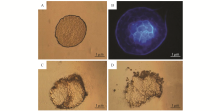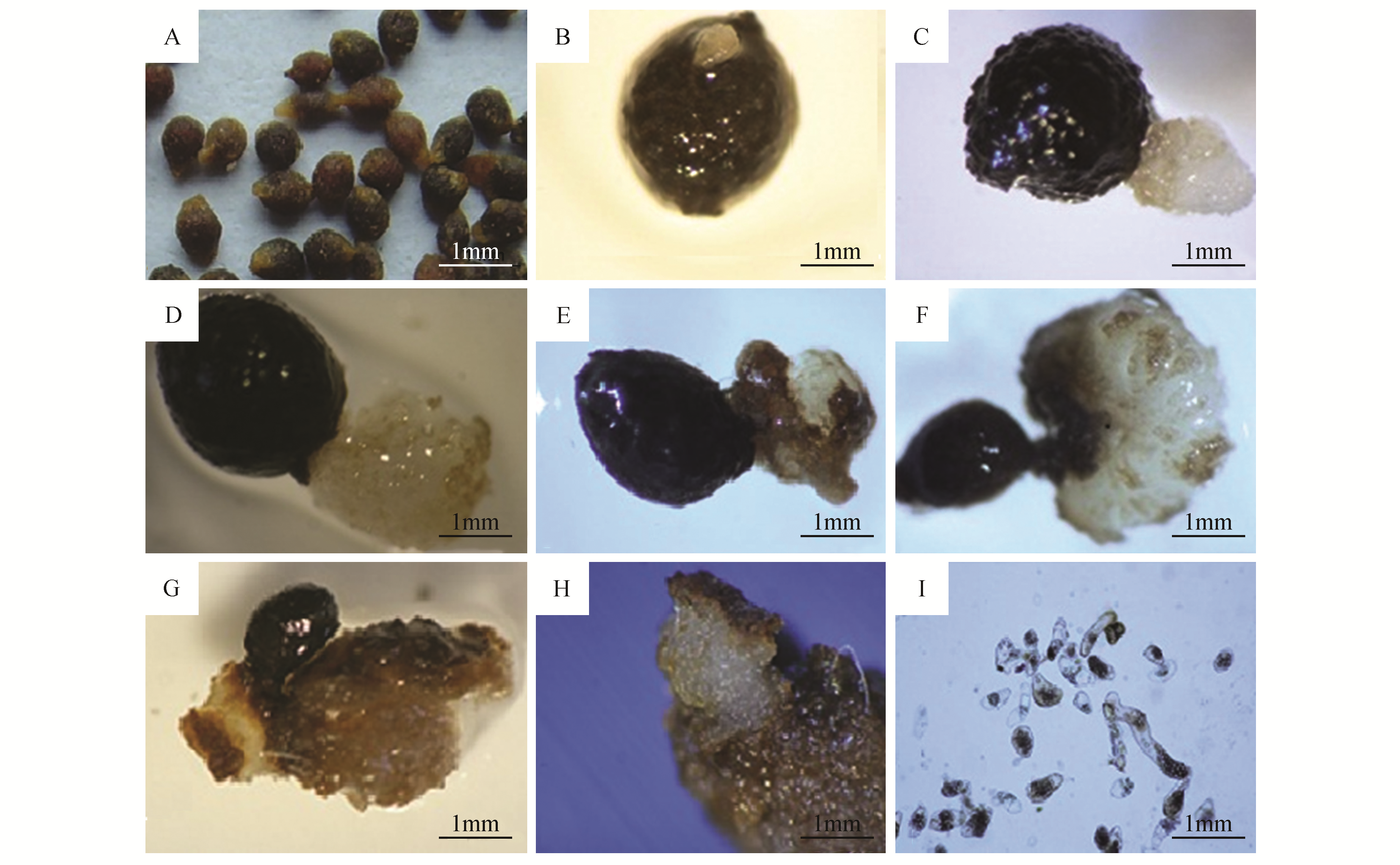Bulletin of Botanical Research ›› 2020, Vol. 40 ›› Issue (6): 846-854.doi: 10.7525/j.issn.1673-5102.2020.06.007
Previous Articles Next Articles
Received:2019-12-20
Online:2020-11-20
Published:2020-11-04
Contact:
Gui-Lin CHEN
E-mail:guilinchen61@163.com
About author:YUE Xin(1983—),female,lecturer,Ph.D.,mainly engaged in biotechnology research on Traditional Chinese Medicine.
Supported by:CLC Number:
Xin YUE, Gui-Lin CHEN. In vitro Germination,Callus Induction and Primary Haustorium Organogenesis in the Parasitic Plant Cynomorium songaricum[J]. Bulletin of Botanical Research, 2020, 40(6): 846-854.
Add to citation manager EndNote|Ris|BibTeX
URL: https://bbr.nefu.edu.cn/EN/10.7525/j.issn.1673-5102.2020.06.007
Table 1
Synergistic effects of 2,4-dichlorophenoxyacetic acid(2,4-D),kinesin(KT) and gibberellin(GA3) on callus induction in C.songaricum Rupr. Seeds
| Treatment | Plant growth regulator(mg·mL-1) | Rate of callus induction(%) | ||
|---|---|---|---|---|
| 2,4-D | KT | GA3 | ||
| 1 | 0.5 | 0.1 | 0.5 | 1.7±1.5f |
| 2 | 1.0 | 0.5 | 1.0 | 13.7±3.1a |
| 3 | 2.0 | 1.0 | 2.0 | 9.0±1.0b |
| 4 | 1.0 | 0.1 | 2.0 | 5.3±1.5d |
| 5 | 2.0 | 0.5 | 0.5 | 2.7±1.2ef |
| 6 | 0.5 | 1.0 | 1.0 | 7.3±1.5c |
| 7 | 2.0 | 0.1 | 1.0 | 3.3±1.5e |
| 8 | 0.5 | 0.5 | 2.0 | 6.0±1.7cd |
| 9 | 1.0 | 1.0 | 0.5 | 2.3±0.6ef |
Table 2
Effect of plant growth regulators on haustorium induction in the callus of C.songaricum seed
| Treatment | Plant growth regulators(mg·mL-1) | Frequency of haustorium formation(%) | Number ofhaustorium | |
|---|---|---|---|---|
| 2.4-D | KT | |||
| 1 | 0.00 | 0.25 | 0.0±0.0b | 0.0±0.0c |
| 2 | 0.25 | 0.25 | 33.3±23.1b | 3.7±0.6b |
| 3 | 0.50 | 0.25 | 66.7±30.6a | 5.3±2.5ab |
| 4 | 0.75 | 0.25 | 13.3±11.5b | 6.7±2.1ab |
| 5 | 1.00 | 0.25 | 16.7±5.8b | 8.3±1.5a |

Fig.1
Development of C.songaricum embryo in different periods of cultivationSeeds cultured for 0, 20, 30 and 40 d were examined.The embryos were obtained by crushing the seeds with another microscope slide, transferred to the formalin-aceto-alcohol(FAA) stationary liquid medium for 24 h, and observed with bright ?eld illumination(Fig.1A,C and D). The embryo was stained with a fluorochrome and observed with a fluorescence objective lens(Fig.1B)


Fig.2
Callus development in different periods of cultivation in C.songaricumThe embryo broke through the seed coat at the micropylar end after 40 days of culture(Fig.2B). The radicle continued to elongate in the following days(Fig.2C). The radicle’s top became intumescent(Fig.2D) and eventually formed a callus(Fig.2E). The callus was pure white and dense, and grew rapidly from the radicle(Fig.2F). After another 20 d, it became brown(Fig.2G), and embryogenic callus formation occurred(Fig.2H). Embryogenic cells were mostly cylindrical, with large nuclei and starch grains(Fig.2I)

| 1 | Jin S W,Eerdunbayaer,Doi A,et al.Polyphenolic constituents of Cynomoriumsongaricum Rupr.and antibacterial effect of polymeric proanthocyanidin on methicillin-resistant Staphylococcusaureus[J].Journal of Agricultural and Food Chemistry,2012,60(29):7297-7305. |
| 2 | Ma C M,Nakamura N,Miyashiro H,et al.Inhibitory effects of constituents from Cynomoriumsongaricum and related triterpene derivatives on HIV-1 protease[J].Chemical and Pharmaceutical Bulletin,1999,47(2):141-145. |
| 3 | Ma C M,Wei Y,Wang Z G,et al.Triterpenes from Cynomoriumsongaricium-analysis of HCV protease inhibitory activity,quantification,and content change under the influence of heating[J].Journal of Natural Medicines,2009,63(1):9-14. |
| 4 | Nakamura N.Inhibitory effects of some traditional medicines on proliferation of HIV-1 and its protease[J].Yakugaku Zasshi,2004,124(8):519-529. |
| 5 | Press M C,Scholes J D,Watling J R.Parasitic plants:physiological and ecological interactions with their hosts[M].//Press M C,Scholes J D,Barker M G.Physiological Plant Ecology.Cambridge:Cambridge University Press,1999:175-97. |
| 6 | Yoshida S,Shirasu K.Plants that attack plants:molecular elucidation of plant parasitism[J].Current Opinion in Plant Biology,2012,15(6):708-713. |
| 7 | Keyes W J,Taylor J V,Apkarian R P,et al.Dancing together.Social controls in parasitic plant development[J].Plant Physiology,2001,127(4):1508-1512. |
| 8 | Shen H,Ye W,Hong L,et al.Progress in parasitic plant biology:host selection and nutrient transfer[J].Plant Biology,2006,8(2):175-185. |
| 9 | Zehhar N,Ingouff M,Bouya D,et al.Possible involvement of gibberellins and ethylene in Orobancheramosa germination[J].Weed Research,2010,42(6):464-469. |
| 10 | Mohamed A H,Ejeta G,Housley T L.Strigaasiatica seed conditioning and 1-aminocyclopropane-1-carboxylate oxidase activity[J].Weed Research,2010,41(2):165-176. |
| 11 | Stewart G R,Press M C.The physiology and biochemistry of parasitic angiosperms[J].Annual Review of Plant Physiology and Plant Molecular Biology,1990,41:127-151. |
| 12 | Yoshida S,Cui S K,Ichihashi Y,et al.The Haustorium,a specialized invasive organ in parasitic plants[J].Annual Review of Plant Biology,2016,67:643-667. |
| 13 | Spallek T,Melnyk C W,Wakatake T,et al.Interspecies hormonal control of host root morphology by parasitic plants[J].Proceedings of the National Academy of Sciences of the United States of America,2017,114(20):5283-5288. |
| 14 | Keyes W J,O'malley R C,Kim D,et al.Signaling organogenesis in parasitic angiosperms:Xenognosin generation,perception,and response[J].Journal of Plant Growth Regulation,2000,19(2):217-231. |
| 15 | Ihl B,Jacob F,Sembdner G.Studies on Cuscutareflexa ROXB.V.The level of endogenous hormones in the parasite,Cuscuta reflexa,and its host,Viciafaba L.,and a suggested role in the transfer of nutrients from host to parasite[J].Plant Growth Regulation,1984,2(2):77-90. |
| 16 | Klaren C H.Physiological aspects of the hemiparasite Rhinanthus serotinus.Groningen:University of Groningen,1975. |
| 17 | Paliyath G,Maheshwari R,Mahadevan S.Initiation of Haustoria in Cuscuta by Cytokinin application[J].Current Science,1978,47(12):427-429. |
| 18 | Huang J Z,Li Y H.A study on the developmental anatomy of haustoria in Cusutajaponca choisy induced by exogenous cytokinin application[J].Journal of Nanjing Agricultural University,1991,14(2):23-28. |
| 19 | Dong S L,Chen N L,Zhang Y,et al.Preliminary study on dormancy and germination of Cynomoriumsongaricum seed[J].Arid Zone Research,2011,28(4):654-659. |
| 20 | Mwase W,Mvula T.Effect of seed size and pre-treatment methods of Bauhiniathonningii Schum.on germination and seedling growth[J].African Journal of Biotechnology,2011,10(26):5143-5148. |
| 21 | Bewley J D.Seed germination and dormancy[J].Plant Cell,1997,9(7):1055-1066. |
| 22 | Ren M Y,Yang G,Du L S,et al.Research advances in medicinal plants of Cynomorium songaricum[J].Journal of Biology,2018,35(5):95-98. |
| 23 | Joel D M,Back A,Kleifeld Y,et al.Seed conditioning and its role in Orobanche seed germination:inhibition by paclobutrazol[M].//Wegmann K,Musselman L J.Progress in Orobanche Research.Proceedings of the International Workshop on Orobanche Research.Tubingen:FRG,1991:147-156. |
| 24 | Joel D M,Stevens J C,Matthews D E.Germination of weedy root parasites[M].//Kigel J,Galili C.Seed Development and Germination.New York:Marcel Dekker,1995:567-598. |
| 25 | Joel D M.The long-term approach to parasitic weeds control:manipulation of specific developmental mechanisms of the parasite[J].Crop Protection,2000,19(8-10):753-758. |
| 26 | Deeks S J,Shamoun S F,Punja Z K.In vitro germination and development of western hemlock dwarf mistletoe[J].Plant Cell,Tissue and Organ Culture,2001,66(2):97-105. |
| 27 | Ang S L P,Yong J W H.A protocol for invitro germination and sustainable growth of two tropical mistletoes[J].Plant Cell,Tissue and Organ Culture,2005,80(2):221-228. |
| 28 | Das P,Kar M,Sahoo S.In vitro hormone-regulated growth and floral induction of Cuscutareflexa:a parasitic angiosperm[J].Acta Physiologiae Plantarum,2011,33(3):1031-1035. |
| 29 | Cui S K,Wada S,Tobimatsu Y,et al.Host lignin composition affects haustorium induction in the parasitic plants Phtheirospermumjaponicum and Strigahermonthica[J].New Phytologist,2018,218(2):710-723. |
| 30 | Tomilov A A,Tomilova N B,Abdallah I,et al.Localized hormone fluxes and early haustorium development in the hemiparasitic plant Triphysariaversicolor[J].Plant Physiology,2005,138(3):1469-1480. |
| 31 | Kuijt J.The biology of parasitic flowering plants[M].Berkeley:University of California Press,1969. |
| 32 | Ishida J K,Yoshida S,Ito M,et al.Agrobacterium rhizogenes-mediated transformation of the parasitic plant Phtheirospermumjaponicum[J].PLoS One2011,6(10):e25802. |
| 33 | Bandaranayake P C G,Filappova T,Tomilov A,et al.A single-electron reducing quinone oxidoreductase is necessary to induce haustorium development in the root parasitic plant Triphysaria[J].Plant Cell,2010,22(4):1404-1419. |
| 34 | Kokla A,Melnyk C W.Developing a thief:Haustoria formation in parasitic plants[J].Developmental Biology,2018,442(1):53-59. |
| 35 | Goyet V,Billard E,Pouvreau J B,et al.Haustorium initiation in the obligate parasitic plant Phelipancheramosa involves a host-exudated cytokinin signal[J].Journal of Experimental Botany,2017,68(20):5539-5552. |
| 36 | Ishida J K,Wakatake T,Yoshida S,et al.Local auxin biosynthesis mediated by a YUCCA flavin monooxygenase regulates Haustorium development in the parasitic plant Phtheirospermumjaponicum[J].Plant Cell,2016,28(8):1795-1814. |
| [1] | Bo XU, Fu-Sun SHI, Li-Hua WANG, Zi-Song YANG. Effects of Altitude on Phenology and Morphological Characteristics of Fritillaria unibracteata [J]. Bulletin of Botanical Research, 2021, 41(5): 666-674. |
| [2] | LIU Xiong-Fang, LI Tai-Qiang, ZHANG Xu, LI Zheng-Hong, WAN You-Ming, AN Jing, LIU Xiu-Xian, MA Hong. Characteristic Analysis of Microsatellites in the Transcriptome of Phyllanthus emblica,an Important Edible and Medicinal Plant [J]. Bulletin of Botanical Research, 2019, 39(2): 294-302. |
| [3] | XU Hai-Jun, CHENG Xin-Yu, WANG Xiao-Fei, GUAN Xiang-Jun. Effects of Different Nitrogen Level on Growths of Moringa oleifera Seedling under Northern Facilities of China [J]. Bulletin of Botanical Research, 2019, 39(1): 54-60. |
| [4] | YAO Xiao-Lan, ZHOU Lin, FENG Mao-Song, HAO Jian-Feng, RAO Yuan-Lin, YAO Jun-Yu, QI Jin-Qiu. Effects of Drought Stress on the Growth and Biomass of Phoebe zhennan'seedling in Different Substrates Net Container [J]. Bulletin of Botanical Research, 2018, 38(1): 81-90. |
| [5] | LIU Pei-Wei, ZHANG Yu-Xiu, HE Ming-Jun. Anatomic Study of Dracaena cambodiana Pierre ex. Gagnep [J]. Bulletin of Botanical Research, 2017, 37(5): 645-650. |
| [6] | XU Hai-Jun, CHENG Xin-Yu, WANG Xiao-Fei, SUN Yu-Feng. Effects of Different Culture Medium on Moringa Seedling Growth and Correlation analysis in Northern China [J]. Bulletin of Botanical Research, 2017, 37(2): 242-248. |
| [7] | LIU Shi-Chao, ZHOU Zai-Zhi, ZHANG Jin-Hao, LIANG Kun-Nan, MA Hua-Ming, HUANG Gui-Hua. Rooting Impact Factors of Callicarpa nudiflora Softwood Cuttings [J]. Bulletin of Botanical Research, 2016, 36(5): 739-746. |
| [8] | CHANG Bo-Wen;FENG Shi;ZHAO Xiao-Ju;ZHANG Xue-Ke;DUAN Xi-Hua*. Organ-specific Distribution of Alkaloid Accumulations in Catharanthus roseus Artificially Cultivated in Fuyang,Zhejiang Province and Wenchang,Hainan Province [J]. Bulletin of Botanical Research, 2012, 32(3): 381-384. |
| [9] | GUO Ling-Ling;MIAO Shu-Kui;JI Qiao-Ling*;JIANG Li. High Frequency Somatic Embryogenesis and Histological Observation on Linum usitatissimum L. ‘Fany’ [J]. Bulletin of Botanical Research, 2011, 31(3): 306-312. |
| [10] | WANG Xue-Jie;SUN Hai-Feng;XIE Dao-Sheng;WU Bin;QIN Xue-Mei*. Comparison of the Content of Major Flavonoids in the Introduced and Cultivated Radix Astragali [J]. Bulletin of Botanical Research, 2011, 31(3): 358-362. |
| [11] | CHAI Min-Wei;SHI Fu-Chen*;MA Yan. Inhibitory Effect of Algae Growth and HPLC Analysis of Allelochemicals from Stephania tetrandra [J]. Bulletin of Botanical Research, 2010, 30(6): 758-762. |
| [12] | LIU Wei;ZHANG Jia-Chao;DENG Guang-Hua*. Influence of Cultivation Time on the Rhizosphere Microbial Diversity of Syzygium grijsii and Its PCR-DGGE Analysis [J]. Bulletin of Botanical Research, 2010, 30(5): 582-587. |
| [13] | SUN Hai-Feng, WANG Xi-Jun, WU Xiu-Hong, MENG Xiang-Cai, ZHOU Lei, QU Xiang-Qian. Effect of cultivated measures on the output of gentian and content of geitiopicroside and swertiamarin [J]. Bulletin of Botanical Research, 2004, 24(3): 335-338. |
| [14] | DUAN Xi-Hua, MAO Zi-Jun. MEDICINAL PLANT RESOURCES OF FOREST REGION IN HEILONGJIANG PROVINCE AND THEIR DISTRICTING [J]. Bulletin of Botanical Research, 2003, 23(1): 98-102. |
| [15] | LI Dong-liang, WANG Ben-jun, WANG Rui-jie, DING Chang-fu. THE STUDY OF CULTIVATED KOREAN PINE IN DAXING ANLING, NEIMENGGUL [J]. Bulletin of Botanical Research, 2000, 20(3): 294-299. |
| Viewed | ||||||
|
Full text |
|
|||||
|
Abstract |
|
|||||
